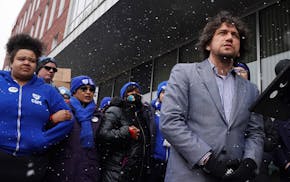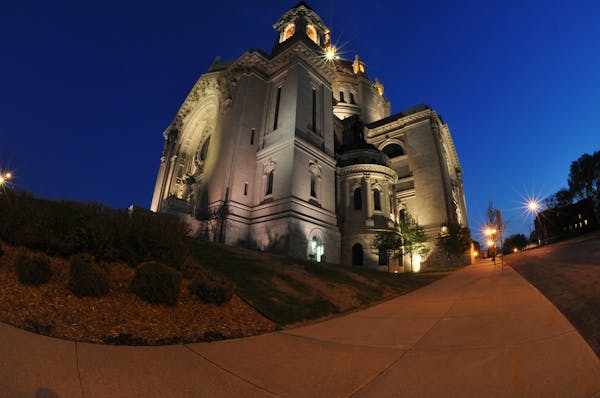For Palm Sunday, the polished floors of the Cathedral of St. Paul shine in mirror-like brilliance, reflecting a blaze of multicolored light streaming through the massive stained-glass rose windows.
Voices rising from the choir loft are accompanied by the triumphant blast of pipe organs as 1,000 or more worshipers gather under the copper-clad dome to celebrate mass.
It's here, high atop a hill overlooking downtown St. Paul, where Catholics have come for the past century to worship and wed and pay tribute to those who have passed on.
And it's here, over the next year, where they will return again and again to celebrate the 100th anniversary of a spiritual shrine through concerts and food drives and even a softball tournament.
At the heart of all the hoopla and history, however, the cathedral stands as an active community of faith.
"I don't want it to simply become a museum or a monument," said the Rev. John Ubel, its 22nd rector. "It is for the worship of God."
The first mass 100 years ago on Palm Sunday carried powerful significance, marking the opening of a cathedral that seemed an unlikely undertaking, if not impossible.
Overcome with emotion as he turned from the altar that day to see more than 2,500 souls — many of whom contributed sums small and large to construction — filling the pews, 77-year-old Archbishop John Ireland broke down and wept.
Ireland said later, "There should be no one who, entering this cathedral, is not able to say 'It is mine.' "
Ubel now administers a church that draws 200,000 visitors a year and has hosted the weddings and funerals of some of Minnesota's most prominent citizens.
As he delivered a homily on obedience to God's will at the 10 a.m. mass last Sunday, more than 550 worshipers gathered in a building that stands 306 feet tall and can hold 3,000 people. Some couldn't resist the urge to look up and around at the stained-glass windows, statues and paintings that fill a structure placed on the National Register of Historic Buildings in 1974.
When mass ended, Tom Macuk of McHenry, Ill., pulled out his iPhone and began taking pictures. He and his wife were visiting their son, a medical student at the University of Minnesota, and friends told them that they had to see the cathedral.
"It's amazing," Macuk said. "This is a work of art. Everything that's here is beautiful."
Across the aisle and two pews up, Tyler and Tara Richter of Cottage Grove prayed with three of their five children. The other two helped during mass — one as an usher, the other collecting church bulletins. The Richters are among about 2,000 families that belong to the cathedral parish.
"When you walk in, it's breathtaking and it can seem so big," said Tara Richter, whose family has worshiped at the cathedral for the past four years. "But everyone here works to be a part of the community, to make it as cozy as it can be."
Their children sing in the children's choir. Their little ones are in the Good Shepherd Montessori program.
Renee Schoenfelder of Burnsville has belonged to the cathedral parish for 12 years — after she converted to Catholicism — and helped start the parish moms group that meets every other month. She was drawn to the cathedral by its beauty, she said. But it feels like a family to her.
"So many just think of the grandeur of this place," she said. "But we are really a small community in a large building. We are more close-knit."
An unexpected opportunity
Ireland almost didn't think it would be possible to build such a spectacular church, said cathedral archivist Celeste Raspanti.
It wasn't that there wasn't a need.
The first cathedral — defined as the bishop's church — was a log chapel on a bluff overlooking the Mississippi River that gave the settlement of Pig's Eye the more saintly name of St. Paul. But it was quickly outgrown, prompting the building of a second cathedral downtown. That, too, was replaced just a few years later by a larger cathedral built nearby.
By the time Ireland was named the first archbishop of St. Paul in 1884, it was clear that the community had outgrown that building, too, and needed yet another new home.
But, Raspanti said, while there were wealthy Catholics in St. Paul, the city was largely made of up of immigrants with little money. Ireland thought it might be better to leave the work of building a new cathedral to a younger man.
Then, in 1904, two St. Paul businessmen presented Ireland with the deed to the Kittson mansion property at the top of St. Anthony Hill. They intended to use the land to build a new home for the archbishop.
But Ireland had a better idea.
"Not my house, but for the house of God," the archbishop said, according to Raspanti. "The hand of God is in this."
Committees were formed, an architect selected. For the next 11 years, Catholics throughout the Twin Cities collected the money to build their new spiritual home on the hill. Children gathered coins, workers pooled dollars, captains of industry signed large checks.
Every contribution was recorded in the Founders Book. Even the name of Ubel's grandfather is written there.
In 1907, workers laid the cornerstone. By May 1914, the exterior was complete. On March 28, 1915 — Palm Sunday — Ireland celebrated the first mass. Two weeks later, a long procession of Catholics marched in a line up the hill for the cathedral's formal dedication.
But the building was far from complete. The whitewashed walls were unadorned. There was no stained glass in the windows. Ireland died three years later at age 80. It would take another half-century of work — and fundraising — by several subsequent archbishops to finish the cathedral's interior and windows.
And the upkeep continues.
A $30 million project to replace the roof and spruce up the exterior was completed more than 14 years ago. More recently, the nonprofit Cathedral Heritage Foundation has led efforts to continue to preserve and restore the building. A recent project: refurbishing the pipe organs.
Caring for the cathedral is "a sacred trust that has been given to us," Ubel said. "It has been given to us and it is up to us to give it to our children."
A muted celebration
For the past three years, the cathedral has served as the backdrop to the Red Bull Crashed Ice event in downtown St. Paul that draws more than 100,000 spectators annually. For those celebrating the centennial in coming months, however, Ubel acknowledged a more subdued series of events.
Part of that is deliberate: the cathedral is the spiritual headquarters of the Archdiocese of St. Paul and Minneapolis — an archdiocese that has been embroiled in priest child sexual abuse scandals and, just weeks ago, filed for Chapter 11 bankruptcy. As part of that financial reorganization, the archdiocese plans to ask a bankruptcy trustee for permission to sell some of its most well-known real estate, including the archbishop's residence and chancery building across from the cathedral and the former cathedral school, just blocks away.
The backdrop of scandal, however, has made planning and raising money for the centennial more difficult, Ubel said. "We have tried to keep it a little more low-key because of that."
For example, instead of a large centennial dinner, plans are being made for a quieter brunch on April 12.
"We cannot deny the tremendous pain that has been caused," Ubel said of the issues confronting the larger Catholic community. "Yet, at the same time, this is a significant building in the state of Minnesota. People sacrificed to make this happen."

Lakewood Cemetery in Minneapolis opens new Welcome Center
Man killed in domestic incident in Coon Rapids, Sheriff's Office says

U of M's interim president meets with pro-Palestinian protest leaders

Legendary boys hockey coach Randolph loses his job

